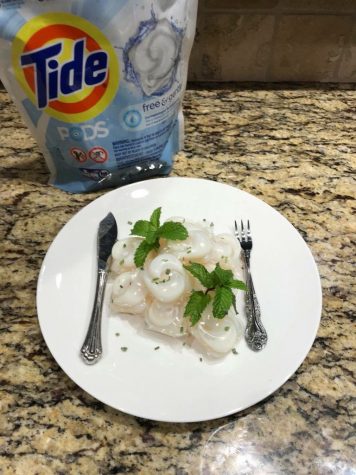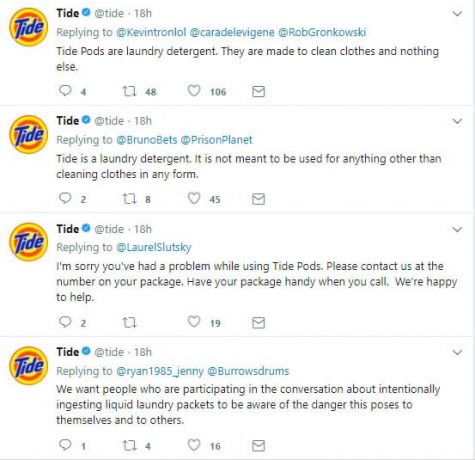PSA: Do Not Eat Tide Pods
January 29, 2018
Do you have an appetite for Tide Pods? In just the first half of January, the American Association of Poison Control Centers (AAPCC) has already reported 39 cases in which teenagers were exposed to detergent packets.
Why, you may ask? The Tide Pod challenge has taken the adolescent world by storm. What started as a meme about the desire to eat Tide Pods has spread into a universal joke amongst millenials; however, some have taken the joke a bit too far. The Tide Pod challenge involves biting into a detergent packet – which has a candy-like appearance – and either spitting out or consuming its poisonous contents, all the while recording it. Participants then dare others to take on the challenge.
This, of course, comes with a plethora of health risks. Once the contents from the packet flow into the person’s mouth, the chemicals result in serious burns to the mouth, esophagus, and respiratory tract. Some victims had to be rushed to the hospital after experiencing cognitive issues. Ingesting the detergent could also lead to vomiting and diarrhea.
In response to the Tide Pod challenge, some have created their own edible Tide Pod look-alikes, while others have simply made jokes about the entire situation.


Tide has been using its social media outlets to warn people of the dangers posed by participating in the Tide Pod challenge and to stop the meme from escalating in response to the rising infamy of their product.
In addition to this, Tide has also summoned Rob Gronkowski from the New England Patriots to help spread the word about the proper use for Tide Pods. In the video posted on Tide’s twitter, Gronkowski says, “Use Tide Pods for washing. Not eating.”
The recipe for Tide Pods is as follows: polyvinyl alcohol (what holds the other ingredients in place, giving it its candy-esque appearance; it’s also closely related to Elmer’s glue), denatonium benzoate (a bitter ingredient to deter people from eating Tide Pods), fatty acid salts (a.k.a. soap), alcohol ethoxy sulfate (a chemical that helps lift stains off of clothing), disodium distyrylbiphenyl disulfonate (a chemical that counteracts the natural yellowing of old clothes to make them appear whiter and brighter), mannanase (a chemical that breaks down gum polymers into smaller carbohydrate fragments), amylase (which attacks starch based stains), subtilisin (a protein enzyme that breaks down stains left behind by your own body), diethylenetriamine pentaacetate (a.k.a. Sodium salt, a molecule that latches onto metals), and calcium formate (a substance that keeps the enzymes in place until the pack is used).
Clearly, there is nothing appetizing about these detergent packs.
So what does all of this mean? First of all, as soon as that Tide Pod is inside your mouth, it will taste bitter; your body might respond with a wave of nausea and in preparation to vomit, your stomach may release extra acids. If your food was to stay down, you might inhale sharply in response to the repulsive taste; this could potentially lodge the pod in your throat, blocking your airway until it’s coating dissolves. The time for this process may vary and the discomfort could send you into a coughing fit.
If you still haven’t spit the pod out, you’ll release saliva mixed with digestive enzymes. Once the coating of the pod starts to dissipate it releases a gel-like substance composed of multiple cleaning agents and stain fighters into your mouth.
When the gel meets with the tissues lining your mouth, the detergent covers the cells that form the outer layer and its pH obliterates these cells at the first touch. The cells then unleash internal matter, which will result in a burning sensation, with sensitivity on your tongue and the inside of your cheeks. This will last anywhere from a few minutes to a few days, similar to when you burn your mouth from hot coffee; however, this is a chemical burn as opposed to a physical burn.
Your body will respond to the burning sensation by kicking your immune system into action. Your immune system will trigger an inflammatory response, which works to fight the possibility of injury and infection. Because of this, the insides of your mouth could swell up; the longer the exposure to the detergent, the more swelling that will occur.
After swallowing the ingredients in the Tide Pod, the back of your throat will experience swelling and a burning sensation; this is because the contents of the Tide Pods are closer to a gel substance as opposed to a liquid, and therefore, it doesn’t go down as smoothly. This can make it hard to breathe, as the circumference of your windpipe will shrink. The lack of oxygen and the extra effort needed to breath will tire you out and you will begin to feel faint.
If the detergent were to make it through your digestive tract, it could result in gastrointestinal distress. On the other hand, if detergent is inhaled in the process of taking on the Tide Pod challenge, it could make its way into your lungs causing coughing, wheezing, and respiratory distress. In severe cases, you may need to be put on a ventilator.
In short, eating laundry detergent has the potential to kill you, although one would have to consume an excessive amount of it. Children are more susceptible to death by eating one detergent pod, but that does not mean teens and older people are in the clear.
According to the AAPCC, the ingestion of detergent pods can even result in seizures and/or comas. Consuming Tide Pods (or any kind of detergent) can have the long term effect of “esophagus strictures,” which may arise from the burns left by the detergent, causing scarring on the esophagus. In addition to scarring, the organ could tighten, putting you at a higher risk for choking.
If you do happen to eat laundry detergent, you should drink water and call poison control (1-800-222-1222) immediately. If, or when, you call poison control, be ready to tell them exactly what kind of detergent pod you ingested so they can give you the best advice for your specific situation. Whatever you do, do not attempt to make yourself vomit. Be on the look-out for symptoms such as irritation and burning in the mouth and esophagus, vomiting, coughing, gagging, gastrointestinal distress, and drooling in children. If you are experiencing severe symptoms, you should call 911 or take a trip to your local emergency room.
Or… you could just be a rational human being and not voluntarily consume poison.
From the time Tide Pods hit the shelves in 2012, young children have found them appealing, thus making it a necessity for federal consumer officials to create a warning to notify parents of the dangers inside the packet. While young children would not know any better than to eat these, teenagers – the ones who are mostly involved in the Tide Pod challenge – should know better.
Long story short, please don’t eat Tide Pods.





